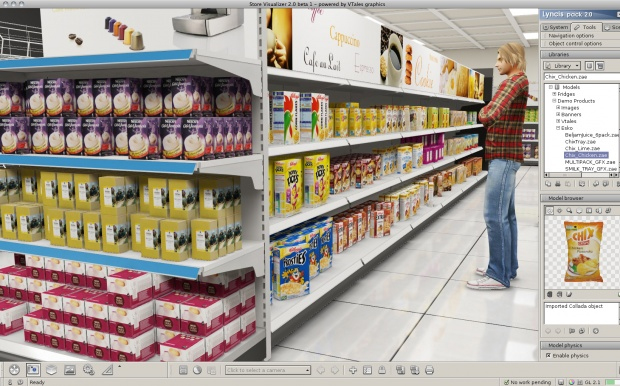Part two of James Matthews-Paul's interview with Jef Stoffels, EskoArtwork's marketing director, at drupa.
Read part one here.

Store Visualiser, launched at drupa, allows designers and pre-press operators to conceive packaging and associated
displays with a true anticipation of the store environment
Esko has launched Store Visualiser, a 3D software interface which allows users to picture packaging in its final context. Are there plans to introduce this for other markets?
In a way it already exists for sign and display. We've really wanted to show a holistic approach with this; users can start designing the package or display in 3D from the first moment. We make sure that someone who's creating the structure – the box or the packaging – can see immediately that the size, shape, flaps, overlaps and content are correct. This means we can visualise on the screen a hyper-realistic virtual mock-up of what the display will look like, including the texture, the varnish and other factors that will affect the print.
We can do that not only for individual packs but also for a bag in a box within a secondary pack inside a display. So we can see these things in a shell display or a supermarket aisle, and based on the pure production data we can build a whole shopping display, complete with packaging and advertising right down to wobblers, with the right lighting atmosphere and how it all works on that stock. Really, it's a QA tool to ensure that what you had on your screen will be produced as you visualised it. It may look like a video game but it's not just a design gimmick: we've been able to transform that style of interface into a business solution for retailers and brand owners.
Do you think its ludic nature adds to the appeal?
It has a certain attraction and sexiness. After all, we work in the graphic arts sector, so people are good at visualising things – but there's nothing wrong with being productive and having a good design in front of you, so why not?
Last time, people called it the ink-jet drupa, or the workflow drupa. How do you see drupa 2012 by comparison?
You can't ignore the buzz here that digital has taken centre stage. HP and Landa have literally moved their way into the middle of the show, and they're challenging all the traditional technologies. Until now the traditional press manufacturers have been able to keep out the pressure presented by digital. But they can't ignore it any more, and I think we've come to this phase for different reasons. The traditional graphic arts industry is becoming a media industry, where digital print is taking a much more prominent role than it ever did, and on different levels.
It's not just Indigo versus Heidelberg; it's digital media, copying, print-on-demand – all these techniques that eat fragments [of non-digital industries]. It's the shift of applications that existed before in print onto interfaces like the iPad. It might sound negative, but it seems like some parts of graphic arts are dissolving into other industries. There's a shake-up happening and I think you see that here – it's not a marginal phenomenon.
Which parts of the printing industry really need to have a good think about their future?
All aspects of the graphic arts industry must, and should have already. If you look at what's happening in commercial print, newspapers and book printing, these trends are being confirmed and accelerated here. That doesn't mean these sectors will go away; it is a permanent evolution or shift. Books will go onto Kindle and will be lower in the volume, so more effective printing techniques and [business strategies] will develop.
But the graphics arts industry has shown, in the last decade, that it is innovative and combative, and able to fight back. Commercial printers have shifted their business models. Look in the packaging industry, for instance, at trade shops that were producing plates for packaging printers. Today, they're calling themselves media houses, because they'll do asset management for all different media. That makes them successful as well – they converted.
So I'm not that negative; I think the industry will reshape or reinvent itself. Players will disappear and consolidations will happen. In my personal opinion you can look at the graphic arts industry and compare it to – you name it – pharmaceuticals, plastics, automobiles. It's more arts and crafts with lower standardisation. Certainly in packaging there's no such thing as standard; every box and bag is different, and everyone has their own way of working. But I think we are on the road to a much more standardised, automated, industrialised industry.